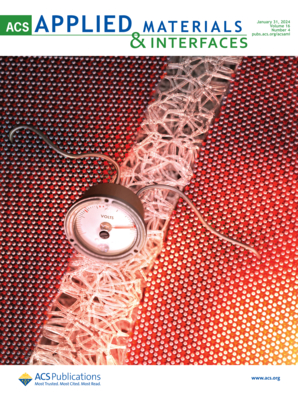用释放抗坏血酸-2-磷酸的聚(l-内酯-环己基内酯)膜促进细胞增殖和胶原蛋白生成,治疗盆腔器官脱垂
IF 8.2
2区 材料科学
Q1 MATERIALS SCIENCE, MULTIDISCIPLINARY
引用次数: 0
摘要
盆腔器官脱垂(POP)困扰着全球数百万妇女。盆腔脏器脱垂患者的盆底支撑力减弱,导致盆腔脏器下坠至阴道内,造成膨出感、排尿、排便和/或性功能障碍。然而,针对复发性 POP 的现有手术修复方法仍然不够完善,因此迫切需要更有效的替代方法。胶原蛋白是盆底组织中提供结构支撑的重要成分,其生成受抗坏血酸的控制。因此,我们在体外研究了新型释放抗坏血酸-2-磷酸(A2P)的聚(l-内酯-环己内酯)(PLCLA2P)膜,以促进细胞增殖和细胞外基质蛋白的生成,从而加强骨盆筋膜的天然支撑力,促进 POP 的应用。我们通过使用人阴道成纤维细胞(hVFs)和人脂肪源性干/基质细胞(hASCs)进行细胞培养分析,分析了 PLCLA2P 与 PLCL 相比的机械性能和对细胞反应的影响。此外,还对 PLCLA2P 膜释放 A2P 的情况进行了体外评估。与 PLCL(3.7 ± 0.6 兆帕)相比,PLCLA2P 在体外最初四周的拉伸强度(2.2 ± 0.4 兆帕)略低。在体外培养的前 48 小时内,A2P 的释放速度最快。我们的研究结果表明,与 PLCL 相比,在释放 A2P 的 PLCLA2P 上,hVFs 和 hASCs 的增殖和胶原蛋白生成明显增加。此外,在 hVFs 中检测到了细胞外胶原 I 型纤维,这表明 PLCLA2P 增强了胶原的成熟。此外,与普通 PLCL 相比,在 hVFs 和 hASCs 中检测到 PLCLA2P 上细胞外基质蛋白表达增加。总之,这些发现凸显了 PLCLA2P 作为一种促进组织再生的候选材料在 POP 组织工程应用中的潜力。本文章由计算机程序翻译,如有差异,请以英文原文为准。
Promoting cell proliferation and collagen production with ascorbic acid 2-phosphate -releasing poly(l-lactide-co-epsilon-caprolactone) membranes for treating pelvic organ prolapse
Pelvic organ prolapse (POP) afflicts millions of women globally. In POP, the weakened support of the pelvic floor results in the descent of pelvic organs into the vagina, causing a feeling of bulging, problems in urination, defecation and/or sexual function. However, the existing surgical repair methods for relapsed POP remain insufficient, highlighting the urgent need for more effective alternatives. Collagen is an essential component in pelvic floor tissues providing structural support, and its production is controlled by ascorbic acid. Therefore, we investigated novel ascorbic acid 2-phosphate (A2P) -releasing poly(l-lactide-co-epsilon-caprolactone) (PLCLA2P) membranes in vitro to promote cell proliferation and extracellular matrix protein production to strengthen the natural support of the pelvic fascia for POP applications. We analysed the mechanical properties and the impact of PLCLA2P on cellular responses through cell culture analysis using human vaginal fibroblasts (hVFs) and human adipose-derived stem/stromal cells (hASCs) compared to PLCL. In addition, the A2P release from PLCLA2P membranes was assessed in vitro. The PLCLA2P demonstrated slightly lower tensile strength (2.2 ± 0.4 MPa) compared to PLCL (3.7 ± 0.6 MPa) for the first four weeks in vitro. The A2P was most rapidly released during the first 48 hours of in vitro incubation. Our findings demonstrated significantly increased proliferation and collagen production of both hVFs and hASCs on A2P -releasing PLCLA2P compared to PLCL. In addition, extracellular collagen type I fibres were detected in hVFs, suggesting enhanced collagen maturation on PLCLA2P. Moreover, increased extracellular matrix protein expression was detected on PLCLA2P in both hVFs and hASCs compared to plain PLCL. In conclusion, these findings highlight the potential of PLCLA2P as a promising candidate for promoting tissue regeneration in applications aimed for POP tissue engineering applications.
求助全文
通过发布文献求助,成功后即可免费获取论文全文。
去求助
来源期刊

ACS Applied Materials & Interfaces
工程技术-材料科学:综合
CiteScore
16.00
自引率
6.30%
发文量
4978
审稿时长
1.8 months
期刊介绍:
ACS Applied Materials & Interfaces is a leading interdisciplinary journal that brings together chemists, engineers, physicists, and biologists to explore the development and utilization of newly-discovered materials and interfacial processes for specific applications. Our journal has experienced remarkable growth since its establishment in 2009, both in terms of the number of articles published and the impact of the research showcased. We are proud to foster a truly global community, with the majority of published articles originating from outside the United States, reflecting the rapid growth of applied research worldwide.
 求助内容:
求助内容: 应助结果提醒方式:
应助结果提醒方式:


